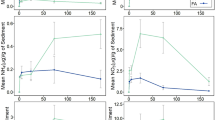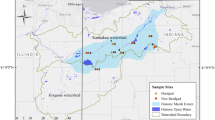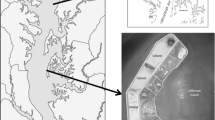Abstract
Nutrient removal is among the most valuable ecosystem services provided by marshes and is often a stated goal of coastal restoration projects. However, the removal capacity of constructed marshes is potentially affected by several site-specific and design factors, such as marsh platform elevation, slope, sediment type, initial planting density and wave climate. Here, the main and interactive effects of these factors on the capacity of constructed marshes to remove nitrate from runoff was explored in field experiments at sites protected from and exposed to waves. At both sites, three experimental blocks were established, each with 24 treatment combinations of factors in experimental flumes: two platform elevations (high and low), two slopes (steep and shallow), two sediment types (coarse and fine grain), and three initial planting densities (0%, 50% and 100% cover). Nutrient rich (KNO3) groundwater solution was fed through the marsh rhizosphere using subsurface diffusers. The relative effects of treatment combinations were then assessed by analyzing porewater NOx concentrations with ANOVA models. None of the treatment combinations had any observable effect on porewater NOx concentrations at the exposed site. However, both sediment type and planting density were significant main effects at the protected site with the lowest NOx concentrations found in flumes with fine sediments and initially planted. These results confirm that design factors can have large implications on nutrient dynamics of constructed marshes in areas protected from waves and that wave energy can substantially reduce the influence of these design factors.





Similar content being viewed by others
Availability of data and materials
Upon acceptance, the authors will publish data and associated metadate on the Mississippi State University Institutional Repository (https://ir.library.msstate.edu/).
References
Armstrong W (1979) Aeration in higher plants. Advances in botanical research, vol 7. Academic Press, London, pp 225–332
Balke T, Bouma TJ, Horstman EM, Webb EL, Erftemeijer PL, Herman PM (2011) Windows of opportunity: thresholds to mangrove seedling establishment on tidal flats. Mar Ecol Prog Ser 440:1–9
Barbier EB (2015) Valuing the storm protection service of estuarine and coastal ecosystems. Ecosyst Serv 11:32–38
Bates D, Maechler M, Bolker B, Walker S (2015) Fitting linear mixed-effects models using lme4. J Stat Softw 67(1):1–48. https://doi.org/10.18637/jss.v067.i01
Bergamaschi BA, Tsamakis E, Keil RG, Eglinton TI, Montluçon DB, Hedges JI (1997) The effect of grain size and surface area on organic matter, lignin and carbohydrate concentration, and molecular compositions in Peru Margin sediments. Geochim Cosmochim Acta 61(6):1247–1260
Bilkovic DM, Mitchell MM, Davis J, Herman J, Andrews E, King A, Mason P, Tahvildari N, Davis J, Dixon RL (2019) Defining boat wake impacts on shoreline stability toward management and policy solutions. Ocean Coast Manag 182:104945
Brix H (1997) Do macrophytes play a role in constructed treatment wetlands? Water Sci Technol 35(5):11–17
Burnham K, Anderson D (2002) Model selection and multi-model inference: a practical information-theoretic approach, 2nd edn. Springer, New York
Coops H, Van der Velde G (1996) Effects of waves on helophyte stands: mechanical characteristics of stems of Phragmites australis and Scirpus lacustris. Aquat Bot 53(3–4):175–185
Davis JL, Nowicki B, Wigand C (2004) Denitrification in fringing salt marshes of Narragansett Bay, Rhode Island, USA. Wetlands 24(4):870–878
Dodds WK (2006) Nutrients and the “dead zone”: the link between nutrient ratios and dissolved oxygen in the northern Gulf of Mexico. Front Ecol Environ 4(4):211–217
Eleuterius LN (1984) Autecology of the black needlerush Juncus roemerianus. Gulf Caribb Res 7(4):339–350
Engelaar WM, Matsumaru T, Yoneyama T (2000) Combined effects of soil waterlogging and compaction on rice (Oryza sativa L.) growth, soil aeration, soil N transformations and 15N discrimination. Biol Fertil Soils 32(6):484–493
Feagin RA, Lozada-Bernard SM, Ravens TM, Möller I, Yeager KM, Baird AH (2009) Does vegetation prevent wave erosion of salt marsh edges? Proc Natl Acad Sci USA 106(25):10109–10113
Fisher J, Acreman MC (2004) Wetland nutrient removal: a review of the evidence. Hydrol Earth Syst Sci 8(4):673–685
Fox L, Valiela I, Kinney EL (2012) Vegetation cover and elevation in long-term experimental nutrient-enrichment plots in Great Sippewissett Salt Marsh, Cape Cod, Massachusetts: implications for eutrophication and sea level rise. Estuar Coast 35(2):445–458
Gedan KB, Kirwan ML, Wolanski E, Barbier EB, Silliman BR (2011) The present and future role of coastal wetland vegetation in protecting shorelines: answering recent challenges to the paradigm. Clim Change 106(1):7–29
Giblin AE, Tobias CR, Song B, Weston N, Banta GT, Rivera-Monroy VH (2013) The importance of dissimilatory nitrate reduction to ammonium (DNRA) in the nitrogen cycle of coastal ecosystems. Oceanography 26(3):124–131
Gittman RK, Peterson CH, Currin CA, Joel Fodrie F, Piehler MF, Bruno JF (2016) Living shorelines can enhance the nursery role of threatened estuarine habitats. Ecol Appl 26(1):249–263
Gupta TR, Foster JH (1973) Valuation of visual-cultural benefits from freshwater wetlands in Massachusetts. J Northeast Econ Counc 2(2):262–273
Hamersley MR, Howes BL (2003) Contribution of denitrification to nitrogen, carbon, and oxygen cycling in tidal creek sediments of a New England salt marsh. Mar Ecol Prog Ser 262:55–69
Hosoi M, Ishida A, Imoto K (1977) Study on Re-Aeration by Waves. Coast Eng Jpn 20(1):121–127
Howes BL, Goehringer DD (1994) Porewater drainage and dissolved organic carbon and nutrient losses through the intertidal creekbanks of a New England salt marsh. Mar Ecol Prog Ser 114(3):289–301
Howes BL, Dacey JWH, Goehringer DD (1986) Factors controlling the growth form of Spartina alterniflora: feedbacks between above-ground production, sediment oxidation, nitrogen and salinity. J Ecol 74:881–898
Hu W, Zhang W, Zhang L, Lin X, Tong C, Lai DY, Chen Y, Zeng C (2019) Short-term changes in simulated inundation frequency differentially affect inorganic nitrogen, nitrification, and denitrification in estuarine marshes. Ecol Ind 107:105571
IPCC (2019) Climate change and land: an IPCC special report on climate change, desertification, land degradation, sustainable land management, food security, and greenhouse gas fluxes in terrestrial ecosystems [P.R. Shukla, J. Skea, E. Calvo Buendia, V. Masson-Delmotte, H.-O. Pörtner, D. C. Roberts, P. Zhai, R. Slade, S. Connors, R. van Diemen, M. Ferrat, E. Haughey, S. Luz, S. Neogi, M. Pathak, J. Petzold, J. Portugal Pereira, P. Vyas, E. Huntley, K. Kissick, M. Belkacemi, J. Malley, (eds.)]. In press
Jesus B, Brotas V, Ribeiro L, Mendes CR, Cartaxana P, Paterson DM (2009) Adaptations of microphytobenthos assemblages to sediment type and tidal position. Cont Shelf Res 29(13):1624–1634
Keddy PA (1985) Wave disturbance on lakeshores and the within-lake distribution of Ontario’s Atlantic coastal plain flora. Can J Bot 63(3):656–660
Kirwan ML, Megonigal JP (2013) Tidal wetland stability in the face of human impacts and sea-level rise. Nature 504(7478):53–60
Kleinhuizen AA, Mortazavi B (2018) Denitrification capacity of a natural and a restored marsh in the Northern Gulf of Mexico. Environ Manag 62(3):584–594
Koch MS, Maltby E, Oliver GA, Bakker SA (1992) Factors controlling denitrification rates of tidal mudflats and fringing salt marshes in south-west England. Estuar Coast Shelf Sci 34(5):471–485
Lenth R (2020) emmeans: estimated marginal means, aka least-squares means. R package version 1.4.6. https://CRAN.R-project.org/package=emmeans
Liu Y, Jiao JJ, Liang W, Luo X (2017) Tidal pumping-induced nutrients dynamics and biogeochemical implications in an intertidal aquifer. J Geophys Res Biogeosci 122(12):3322–3342
Lucas WC, Greenway M (2008) Nutrient retention in vegetated and nonvegetated bioretention mesocosms. J Irrig Drain Eng 134(5):613–623
Martin S, Sparks EL, Constantin AJ, Cebrian J, Cherry JA (2020) Restoring fringing tidal marshes for ecological function and ecosystem resilience to moderate sea-level rise in the Northern Gulf of Mexico. Environ Manag 67(2):384–397
McConchie JA, Toleman IEJ (2003) Boat wakes as a cause of riverbank erosion: a case study from the Waikato River, New Zealand. J Hydrol (New Zealand) 42:163–179
McKee KL, Mendelssohn IA, Hester MW (1988) Reexamination of pore water sulfide concentrations and redox potentials near the aerial roots of Rhizophora mangle and Avicennia germinans. Am J Bot 75(9):1352–1359
Mehvar S, Filatova T, Sarker MH, Dastgheib A, Ranasinghe R (2019) Climate change-driven losses in ecosystem services of coastal wetlands: a case study in the West coast of Bangladesh. Ocean Coast Manag 169:273–283
Mendelssohn IA, McKee KL (1988) Spartina alterniflora die-back in Louisiana: time-course investigation of soil waterlogging effects. J Ecol 76:509–521
Morris JT, Sundareshwar PV, Nietch CT, Kjerfve B, Cahoon DR (2002) Responses of coastal wetlands to rising sea level. Ecology 83(10):2869–2877
Morris JT, Shaffer GP, Nyman JA (2013) Brinson review: perspectives on the influence of nutrients on the sustainability of coastal wetlands. Wetlands 33(6):975–988
Nassauer JI (2004) Monitoring the success of metropolitan wetland restorations: cultural sustainability and ecological function. Wetlands 24(4):756–765
Neubauer SC, Piehler MF, Smyth AR, Franklin RB (2019) Saltwater intrusion modifies microbial community structure and decreases denitrification in tidal freshwater marshes. Ecosystems 22(4):912–928
NOAA (2015) Guidance for considering the use of living shorelines. National Oceanic and Atmospheric Administration, Silver Spring, MD, 36p
Novoveská L, MacIntyre HL (2019) Study of the seasonality and hydrology as drivers of phytoplankton abundance and composition in a shallow estuary, Weeks Bay, Alabama (USA). J Aquac Mar Biol 8(3):69–80
Nyman JA, Walters RJ, Delaune RD, Patrick WH Jr (2006) Marsh vertical accretion via vegetative growth. Estuar Coast Shelf Sci 69(3–4):370–380
R Core Team (2020) R: a language and environment for statistical computing. R Foundation for Statistical Computing, Vienna, Austria. https://www.R-project.org/
Rabalais NN, Turner RE, Wiseman WJ Jr (2002) Gulf of Mexico hypoxia, aka “The dead zone.” Annu Rev Ecol Syst 33(1):235–263
Reddy KR, DeLaune RD (2008) Biogeochemistry of wetlands: science and applications. CRC Press, Boca Raton
Roland RM, Douglass SL (2005) Estimating wave tolerance of Spartina alterniflora in coastal Alabama. J Coast Res 213:453–463
Rupprecht F, Möller I, Evans B, Spencer T, Jensen K (2015) Biophysical properties of salt marsh canopies—quantifying plant stem flexibility and above ground biomass. Coast Eng 100:48–57
Schulze D, Rupprecht F, Nolte S, Jensen K (2019) Seasonal and spatial within-marsh differences of biophysical plant properties: implications for wave attenuation capacity of salt marshes. Aquat Sci 81(4):65
Silinski A, Schoutens K, Puijalon S, Schoelynck J, Luyckx D, Troch P, Meire P, Temmerman S (2018) Coping with waves: plasticity in tidal marsh plants as self-adapting coastal ecosystem engineers. Limnol Oceanogr 63(2):799–815
Silvan N, Vasander H, Laine J (2004) Vegetation is the main factor in nutrient retention in a constructed wetland buffer. Plant Soil 258(1):179–187
Sinsabaugh RL, Findlay S (1995) Microbial production, enzyme activity, and carbon turnover in surface sediments of the Hudson River estuary. Microb Ecol 30(2):127–141
Sloey TM, Hester MW (2018) Impact of nitrogen and importance of silicon on mechanical stem strength in Schoenoplectus acutus and Schoenoplectus californicus: applications for restoration. Wetl Ecol Manag 26(3):459–474
Sparks EL, Cebrian J (2015) Effects of fertilization on grasshopper grazing of northern Gulf of Mexico salt marshes. Estuar Coast 38(3):988–999
Sparks EL, Cebrian J, Biber PD, Sheehan KL, Tobias CR (2013) Cost-effectiveness of two small-scale salt marsh restoration designs. Ecol Eng 53:250–256
Sparks EL, Cebrian J, Smith SM (2014) Removal of fast flowing nitrogen from marshes restored in sandy soils. PLoS ONE 9(10):e111456
Sparks EL, Cebrian J, Tobias CR, May CA (2015) Groundwater nitrogen processing in Northern Gulf of Mexico restored marshes. J Environ Manag 150:206–215
Spieles DJ, Mitsch WJ (1999) The effects of season and hydrologic and chemical loading on nitrate retention in constructed wetlands: a comparison of low-and high-nutrient riverine systems. Ecol Eng 14(1–2):77–91
Temple NA (2021) Improving the cost effectiveness of water wave measurements and understanding of its impact on natural and restored marsh communities. Dissertation, Mississippi State University
Temple NA, Grace JB, Cherry JA (2019) Patterns of resource allocation in a coastal marsh plant (Schoenoplectus americanus) along a sediment-addition gradient. Estuar Coast Shelf Sci 228:106337
Tobias C, Neubauer SC (2019) Salt marsh biogeochemistry—an overview. Coastal wetlands. Elsevier, Amsterdam, pp 539–596
Tobias CR, Anderson IC, Canuel EA, Macko SA (2001) Nitrogen cycling through a fringing marsh-aquifer ecotone. Mar Ecol Prog Ser 210:25–39
Van Slobbe E, de Vriend HJ, Aarninkhof S, Lulofs K, de Vries M, Dircke P (2013) Building with Nature: in search of resilient storm surge protection strategies. Nat Hazards 66(3):1461–1480
VanZomeren CM, White JR, DeLaune RD (2012) Fate of nitrate in vegetated brackish coastal marsh. Soil Sci Soc Am J 76(5):1919–1927
Vasquez EA, Glenn EP, Guntenspergen GR, Brown JJ, Nelson SG (2006) Salt tolerance and osmotic adjustment of Spartina alterniflora (Poaceae) and the invasive M haplotype of Phragmites australis (Poaceae) along a salinity gradient. Am J Bot 93(12):1784–1790
Wetzel RG (2001) Limnology: lake and river ecosystems. Gulf Professional Publishing, Oxford
White DS, Howes BL (1994) Long-term 15N-nitrogen retention in the vegetated sediments of a New England salt marsh. Limnol Oceanogr 39(8):1878–1892
Wigand C, McKinney RA, Charpentier MA, Chintala MM, Thursby GB (2003) Relationships of nitrogen loadings, residential development, and physical characteristics with plant structure in New England salt marshes. Estuaries 26(6):1494–1504
Woodroffe CD (2002) Coasts: form, process and evolution. Cambridge University Press, Cambridge
Yamamoto N, Lopez G (1985) Bacterial abundance in relation to surface area and organic content of marine sediments. J Exp Mar Biol Ecol 90(3):209–220
Yozzo D, Titre J, Sexton J (1996) Planning and evaluating restoration of aquatic habitats from an ecological perspective. Institute for Water Resources, US Army Corps of Engineers, Waterways Experiment Station, Vicksburg, MS, IWR Report 96-EL-4
Zedler JB (1996) Tidal wetland restoration: a scientific perspective and southern California focus. California Sea Grant College System, University of California, La Jolla, CA, p 1996
Zheng Y, Hou L, Liu M, Liu Z, Li X, Lin X, Yin G, Gao J, Yu C, Wang R, Jiang X (2016) Tidal pumping facilitates dissimilatory nitrate reduction in intertidal marshes. Sci Rep 6:21338
Acknowledgements
In addition to our funders, the authors would like to thank Gillian Palino, Andrew Lucore, Matthew Virden, Haley Moss, Jamie Amato, Aaron Macy, Ellee Temple, Bryan Miller and Jamie Phillips-Temple for their assistance with experimental set up and data collection. In addition, the authors thank partners at the Weeks Bay NERR and the Management Application Team for their assistance with the project.
Funding
Funding for this project was provided US EPA Wetlands Program (Grant Number: CD-00D40115-0) and NOAA—Mississippi-Alabama Sea Grant Program (GRANT NUMBER: 8200025414).
Author information
Authors and Affiliations
Contributions
ELS and JC designed experiment; NAT, ELS, JC, SEM and DCF implemented experiment and collected data; NAT performed statistical analyses; NAT, ELS, JC, SEM and DCF prepared the manuscript.
Corresponding author
Ethics declarations
Conflict of interest
The authors do not have any conflicts of interest/competing interests.
Additional information
Publisher's Note
Springer Nature remains neutral with regard to jurisdictional claims in published maps and institutional affiliations.
Supplementary Information
Below is the link to the electronic supplementary material.
Rights and permissions
About this article
Cite this article
Temple, N.A., Sparks, E.L., Cebrian, J. et al. Nitrogen removal in constructed marshes at sites protected from and exposed to waves. Wetlands Ecol Manage 29, 549–564 (2021). https://doi.org/10.1007/s11273-021-09800-0
Received:
Accepted:
Published:
Issue Date:
DOI: https://doi.org/10.1007/s11273-021-09800-0




